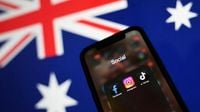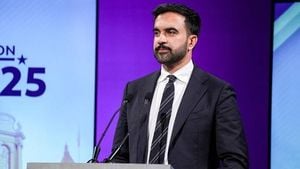Australia is stepping boldly onto the world stage with its new law requiring social media giants to remove users under the age of 16—a move that has drawn both international attention and sharp criticism from the tech industry. With the legislation set to take effect on December 10, 2025, platforms like Facebook, Instagram, TikTok, and potentially others are scrambling to comply, even as they warn that enforcing the ban will be no easy feat.
According to reports by AFP and other outlets, the law obliges major social media platforms to take "reasonable steps" to detect and deactivate accounts belonging to users under 16. Companies that fail to comply face eye-watering fines of up to Aus$49.5 million (US$32 million)—a sum that would make even the world’s largest tech firms sit up and take notice.
At a Senate hearing on Tuesday, October 28, 2025, representatives from Meta—the parent company of Facebook and Instagram—and TikTok confirmed their intention to obey the new rules. TikTok Australia’s policy lead, Ella Woods-Joyce, was unequivocal: "Put simply, TikTok will comply with the law and meet our legislative obligations." But she didn’t mince words about the difficulties ahead. Woods-Joyce warned that the "blunt" age ban could have a raft of unintended consequences, especially for the very group it seeks to protect.
"Experts believe a ban will push younger people into darker corners of the Internet where protections don't exist," Woods-Joyce told lawmakers. The concern is that, rather than keeping kids safe, the law could drive them toward less regulated, riskier platforms where there are fewer—if any—safeguards in place. It’s a classic case of unintended consequences: try to solve one problem, and you might just create another.
Meta’s policy director, Mia Garlick, echoed the sentiment that compliance won’t be a walk in the park. She told the Senate hearing that Meta is facing "numerous challenges" as it works to remove hundreds of thousands of users under 16 by the looming December deadline. "The goal from our perspective, being compliance with the law, would be to remove those under 16," Garlick said. But she was quick to point out that the task presents "significant new engineering and age assurance challenges." In other words, it’s not just a matter of flipping a switch.
Indeed, identifying and removing underage users is a technical and logistical headache. For one thing, Australia’s law does not require companies to verify the age of every single user—an undertaking that would be nearly impossible at the scale of these platforms. Instead, the law mandates that companies take "reasonable steps" to detect and deactivate underage accounts. But what exactly counts as "reasonable"? That’s a question regulators and companies alike are still trying to answer, with just weeks to go before the law kicks in.
The uncertainty hasn’t gone unnoticed by critics. Tech companies have been united in their skepticism of Australia’s approach, describing the legislation as "vague," "problematic," and "rushed." YouTube, which is also expected to fall under the ban, was particularly blunt in its assessment. "The legislation will not only be extremely difficult to enforce, it also does not fulfil its promise of making kids safer online," said Rachel Lord, a local spokeswoman for YouTube, earlier this month.
Australia’s online watchdog has suggested that the ban could extend even further, potentially covering messaging service WhatsApp, streaming platform Twitch, and gaming site Roblox. If that happens, the scope of the law would become even broader, affecting millions more young users who spend their time on these digital playgrounds. The question is: can such a sweeping ban actually work?
There’s no doubt that Australia’s new rules are among the strictest in the world. As The Hindu noted, the ban is drawing keen interest from regulators across the globe, many of whom are wrestling with the dangers of social media and the challenge of protecting children online. With just over a month until the law comes into effect, Australia finds itself in the spotlight as a test case for whether such restrictions can be made to stick.
But the rush to implement the law has left some key questions unanswered. As of late October, officials were still scrambling to clarify exactly what “reasonable steps” will look like in practice. Will companies be able to rely on existing age verification tools, or will they need to develop new ones? And how will regulators measure success—or failure—when it comes to enforcement?
For their part, the tech giants insist they’re taking the law seriously. Meta’s Mia Garlick said the company is investing heavily in new technologies and processes to meet its obligations. TikTok’s Ella Woods-Joyce also reiterated the platform’s commitment to compliance. But both executives made it clear that the road ahead is fraught with technical, ethical, and practical hurdles.
Meanwhile, critics worry that the law’s “one-size-fits-all” approach could do more harm than good. By forcing minors off mainstream platforms, where at least some protections exist, Australia could inadvertently expose them to greater risks elsewhere online. As Woods-Joyce put it, "Experts believe a ban will push younger people into darker corners of the Internet where protections don't exist." It’s a sobering thought, and one that underscores the complexity of regulating the digital world.
Parents, educators, and child safety advocates are watching closely. Some see the law as a necessary step to curb the negative effects of social media on young people, from cyberbullying to mental health issues. Others argue that education and parental involvement are more effective tools than outright bans. The debate is far from settled, and Australia’s experiment may offer valuable lessons—good or bad—for the rest of the world.
There’s also the question of how the law will impact the business models of the tech companies themselves. Young users represent a significant portion of the audience for platforms like TikTok and Instagram. Removing them could have ripple effects on advertising revenue, user engagement, and the broader social media ecosystem. But with hefty fines looming, companies have little choice but to comply—even if it means making tough decisions that could affect their bottom lines.
As the December 10 deadline approaches, all eyes are on Australia. Will the ban achieve its goal of making kids safer online, or will it simply push the problem out of sight and into the shadows? Only time will tell. For now, the world is watching, and the stakes couldn’t be higher—for tech companies, for regulators, and most of all, for the millions of young people who call the internet home.




